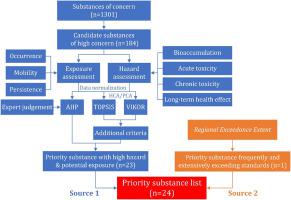Journal of Hazardous Materials ( IF 13.6 ) Pub Date : 2021-09-11 , DOI: 10.1016/j.jhazmat.2021.127142 Ying Liu 1 , Junyi Yu 2 , Haoyu Sun 2 , Tongtong Li 2 , Xiaosong He 3 , Zhifen Lin 4

|
Screening and prioritizing hazardous substances in groundwater is crucial to monitor and control groundwater quality. Total of 283 substances were determined in 213 groundwater samples from the Beijing–Tianjin–Hebei region during 2019–2020. 184 substances were screened as candidates. 22 prioritizing indicators were evaluated and scored for the candidates to reflect their occurrence, mobility, persistence, bioaccumulation, acute and chronic ecotoxicities with different trophic levels, and long-term human health effects. Multi-attribute decision-making technologies were applied to prioritize these candidates, including analytic hierarchy process (AHP), TOPSIS and VIKOR. Greater weightings in AHP were assigned to attributes of occurrence and acute toxicity by experts’ judgment. Hierarchical cluster analysis and principal component analysis were used to transform initial matrix with the 22 indicators into an orthogonalized matrix with 6 principal components, which represented general toxicity to aquatic organism and mammal, bioaccumulation, carcinogenicity & mutagenicity, persistence, and teratogenicity & endocrine, respectively. VIKOR and TOPSIS results were similar, but different from the AHP ranking. Two filter criteria harmonized their difference. Twenty-three substances were proposed as the priority substance with high hazard and potential exposure, and nitrate-nitrogen and ammonia-nitrogen were selected as additional priority substance frequently and extensively exceeding official groundwater quality standard on the regional scale.
中文翻译:

基于暴露和危害评估的华北平原京津冀地区地下水中物质的筛选和优先排序
对地下水中的有害物质进行筛选和优先排序对于监测和控制地下水质量至关重要。2019-2020年京津冀地区213个地下水样品共测定283种物质。184 种物质被筛选为候选物质。对22个优先指标进行了评估和评分,以反映它们的发生、流动性、持久性、生物累积性、不同营养水平的急性和慢性生态毒性以及对人类健康的长期影响。应用了多属性决策技术来对这些候选者进行优先级排序,包括层次分析法 (AHP)、TOPSIS 和 VIKOR。根据专家的判断,AHP 中更大的权重被分配给发生和急性毒性的属性。采用层次聚类分析和主成分分析,将包含22个指标的初始矩阵转化为具有6个主成分的正交矩阵,分别代表对水生生物和哺乳动物的一般毒性、生物累积性、致癌性和致突变性、持久性、致畸性和内分泌性. VIKOR 和 TOPSIS 结果相似,但与 AHP 排名不同。两个过滤器标准协调了它们的差异。23种物质被提出作为高危害和潜在暴露的优先物质,硝酸盐-氮和氨-氮被选为区域范围内频繁且广泛超过官方地下水质量标准的附加优先物质。


























 京公网安备 11010802027423号
京公网安备 11010802027423号